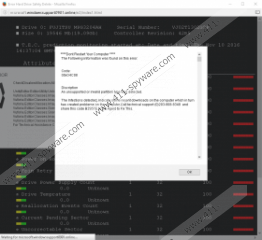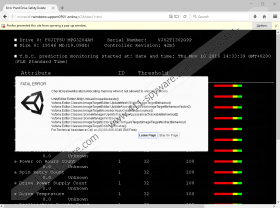Code 00xo4c08 Pop-up Removal Guide
You may find it shocking to see the Code 00xo4c08 Pop-up message while you are peacefully browsing the web, but we are here to tell you that you should not believe this fake alert for a moment. In fact, this is a typical technical support scam that tries to frighten you with an authentic-looking Microsoft system error that is supposed to require your immediate attention and you are pushed to call a given telephone number for technical support. You need to know that neither Microsoft, nor any other software developers will contact you this way. It is all about making you pay for a totally unnecessary program or service that allegedly fixes fake system issues. If you do not want to end up paying for such useless things, you should remove Code 00xo4c08 Pop-up right now.
As a matter of fact, in this case we cannot specifically tell you which malware program is responsible for this malware infection. There are indeed a couple of ways for this fake alert to show up on your screen. First, it is possible that you have installed a malicious freeware bundle recently and it contained adware programs, browser hijackers, or any other malware infection that can redirect you to malicious websites. This is how you encounter Code 00xo4c08 Pop-up in fact: you get redirected to a malicious website (e.g., microsoft.windowssupport0901.online/e2/index1.html) that displays it.
It is easier to get infected with such malware threats than you may think. Even more so when your computer is already infected with adware programs and the like. One click on the wrong content could lead to downloading a free software bundle. This can also happen when you land on suspicious file-sharing and gaming websites and you get confused by the misleading third-party contents. For example, you may find fake buttons and system alerts that could hide malicious downloaders. If you click on such content, you can either directly get redirected to this malicious site that promotes this fake alert or you can drop a package of threats that contains such malware. What you may not know is that even browser hijackers could introduce you to modified search results that could also contain unsafe ads or links that may lead you to such a malicious website. All in all, we believe that you should run a system malware scan as soon as you delete Code 00xo4c08 Pop-up by identifying all possibly harmful applications that may be hiding on your system.
This malware infection is very similar to other technical support scams, including “License has Expired +1-888-303-5121,” “Fake Activation Support 1-877-784-7461,” and “1-877-884-5474 Google Security Warning Message.” Obviously, the message you see on your screen after being attacked by this infection is totally fake. However, it may still appear to be authentic for you if you are not an experienced computer user. Once this malware infection is activated, you are redirected to a malicious website that pretends to be some sort of Microsoft Windows Support page that has all kinds of fake error codes and explanations on it, and a pop-up window that informs you that you must have downloaded a questionable program lately that caused a system error. In order to fix this issue, you are supposed to call (0)203-808-8348 for technical support.
These scams usually claim that you will talk to a Microsoft certified technician but you need to know that Microsoft would never contact you this way. This is rather intrusive and simply a trick for schemers and unreliable salespersons to promote a questionable product or service that could allegedly help you fix those made-up issues. You should not even think about calling this number because you might lose a couple of hundreds of dollars once you get through to a “technician” who would apply his or her “magic” on you to persuade you that you do need this service for a whole year if possible. If you do not want to send your money down the drain, we suggest that you delete Code 00xo4c08 Pop-up and all suspicious programs on your computer.
Since we cannot identify one specific program that is responsible for this fake alert infection, we can only suggest that you should check your installed programs list in Control Panel and uninstall the ones that prove to be suspicious or useless. Please follow our instructions below if you are not familiar with these steps. You can also check your browser settings as well for questionable extensions. If you want to avoid similar threats from invading your privacy and your virtual world, you should make sure that you stay away from suspicious websites and clicking on random third-party contents (ads, fake buttons, and alerts). However, if you wish to have an effective way to protect your computer, we advise you to install a reliable anti-malware application, such as SpyHunter.
Remove Code 00xo4c08 Pop-up from Windows
Windows XP
- Access the Start menu and select Control Panel.
- Click Add or Remove Programs.
- Select the application and click Remove.
Windows Vista/Windows 7
- Press the Windows button on the Taskbar and select Control Panel.
- Choose Uninstall a program.
- Select the application and click Uninstall.
Windows 8/Windows 8.1/Windows 10
- Right-click on the Windows logo in the bottom-left corner and select Control Panel.
- Pick Uninstall a program.
- Select the application and click Uninstall.
Code 00xo4c08 Pop-up Screenshots:



